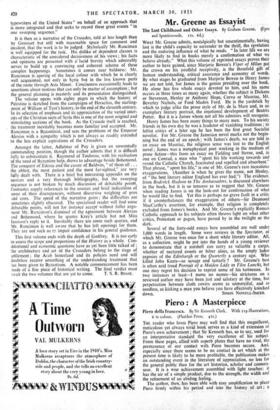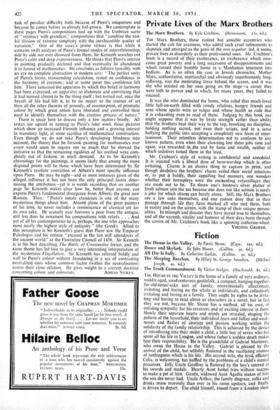Piero : A Masterpiece
THE reader who loves Piero may well find that this magnificent, meticulous yet always vivid book serves as a kind of extension of Piero's own achievement ; that Sir Kenneth has, so to say, used for an interpretative standard the very excellence of his subject. From these pages, allied with superb plates that have no rival, the permanence of our contact with Piero becomes secure. And. especially since there seems to be no contact in art which at the present time is likely to be more profitable, the publication makes an outstanding event in the literature of appreciation, no less for the general public than for the art historian, scholar and connois- seur. It is a wise achievement assembled with light touches: it has the air of a simple product, due to the strength,• the width and the refinement of an abiding feeling.
The author, then, bas been able with easy amplification to place Piero firmly within his period and into the history of art ; a
task of peculiar difficulty both because of Piero's uniqueness and because he comes before us already full-grown. We contemplate in these pages Piero's compositions tied up with the Umbrian scene of " intimacy with grandeur," compositions that " combine the rest- ful illusion of extreme simplicity with the inexhaustible quality of variation." One of the essay's prime virtues is that while it contains swift analyses of Piero's formal modes of interrelationship, side by side nor ever divorced from them, Sir Kenneth searches out Piero's calm and deep expressiveness. He thinks that Piero's interest in painting gradually declined and that eventually he abandoned it in favour of mathematics. He concludes as follows (possibly with an eye on complete abstraction in modern art): " The perfect unity of Piero's forms, transcending calculation, rested on confidence in the harmony of creation ; and at some point this confidence left him. There remained the apparatus by which this belief in harmony had been expressed, an apparatus so elaborate and convincing that it had seemed almost to be the thing itself ; but turned out, once the breath of life had left it, to be no nearer to the essence of art than all the other theories of prosody, of counterpoint, of prismatic colour by which great artists have liberated and controlled their need to identify themselves with the creative process of nature."
There is space here to discuss only a few matters briefly. All critics are agreed in naming as Piero's later work those pictures which show an increased Flemish influence and a growing interest in transitory light, at some sacrifice of mathematical construction. Even though we do not take Piero's developing blindness into account, the theory that he forsook painting for mathematics tout court would seem to require not so much that he showed the initiative as that the remaining rigidities of his method were com- pletely out of fashion, in small demand. As to Sir Kenneth's chronology for the paintings, it seems likely that among the more disputed points will be those which have been determined by Sir Kenneth's resolute conviction of Alberti's most specific influence upon Piero. He may be right—and in most instances given of the alleged influence it has not been the only principal factor deter- mining the attribution—yet it is worth recording that on another page Sir Kenneth makes clear how he, better than anyone, can express Piero's fundamental divergence from Alberti, the great new Roman. Thus: " Piero's innate classicism is one of the many Mysterious things about him. Almdst alone of the great painters of his time, he never includes a reminiscence of classical art for its own sake. He scarcely ever borrows a pose from the antique, still less does he ornament his compositions with reliefs. . . . And yet of all his contemporaries he is, perhaps, the one who approaches most nearly the highest style of antiquity " (the Greek). Allied to this perception is Sir Kenneth's guess that Piero saw the Emperor Paleologus and his retinue " encased in the last stiff splendours of the ancient world," at the Florentine Council of 1439. Sir Kenneth is at his best describing The Battle of Constantine fresco, and the same theme has led him to give a very interesting interpretation of the mysterious Flagellation. Sir Kenneth has referred boldly and well to Piero's colour without foundering in a sea of contrasting neutralised tints whose common factor (within the neutralisation) assists their close relation. He gives weight to a current doctrine































 Previous page
Previous page